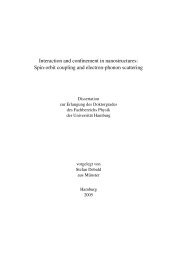Measuring the Electron Beam Energy in a Magnetic Bunch ... - DESY
Measuring the Electron Beam Energy in a Magnetic Bunch ... - DESY
Measuring the Electron Beam Energy in a Magnetic Bunch ... - DESY
You also want an ePaper? Increase the reach of your titles
YUMPU automatically turns print PDFs into web optimized ePapers that Google loves.
1 Introduction<br />
Know<strong>in</strong>g <strong>the</strong> exact position of an electron beam under <strong>the</strong> <strong>in</strong>fluence of a magnetic field<br />
has been at <strong>the</strong> heart of many important experiments <strong>in</strong> <strong>the</strong> history of physics. From <strong>the</strong><br />
first cathode ray tube that was placed next to a piece of magnetized metal to <strong>the</strong> highenergy<br />
beams of modern accelerators travel<strong>in</strong>g through lattices of powerful<br />
electromagnets, <strong>the</strong> position of <strong>the</strong> beam under <strong>the</strong> <strong>in</strong>fluence of a magnetic field gives<br />
<strong>in</strong>formation about <strong>the</strong> momentum of <strong>the</strong> beam. High-precision knowledge of <strong>the</strong> beam<br />
momentum can enable higher precision control of <strong>the</strong> beam. Control of <strong>the</strong> beam<br />
momentum is critical for <strong>the</strong> stability of both <strong>the</strong> wavelength and arrival-time of <strong>the</strong> light<br />
pulses generated by free-electron lasers. The measurement of <strong>the</strong> beam momentum <strong>in</strong> a<br />
free-electron laser with magnetic bunch compressor chicanes is <strong>the</strong> topic of this <strong>the</strong>sis.<br />
The bend<strong>in</strong>g radius, r, of an electron with charge e travel<strong>in</strong>g through a magnetic<br />
dipole field perpendicular to <strong>the</strong> beam direction, B, depends on <strong>the</strong> momentum, p, of <strong>the</strong><br />
particle.<br />
1 B<br />
= e⋅<br />
(1.1)<br />
r p<br />
r r v<br />
is an equation derived from <strong>the</strong> Lorentz force law, F = q ( v × B)<br />
, and <strong>the</strong> relation between<br />
force and momentum F=dp/dt=pv/r. For a rectangular dipole magnet <strong>in</strong> which <strong>the</strong><br />
electron beam enters perpendicularly to one of <strong>the</strong> magnet’s faces, <strong>the</strong> path length of <strong>the</strong><br />
electron’s trajectory is given by<br />
l arc<br />
= r ⋅α , (1.2)

















